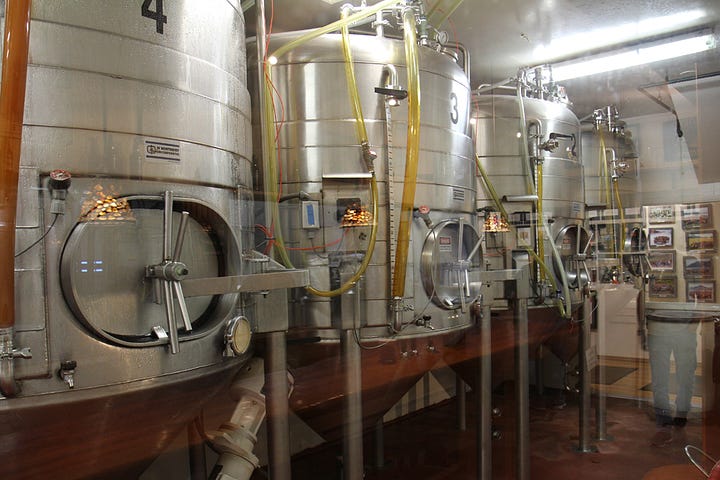An Alaskan Brewery Tour
…continued from Packrafting the Mendenhall River
Whenever I visit a new city, I want to find out what the locals drink. In Juneau, Alaska, the best place to do this is the Alaskan Brewing Company. With seven year-round beers, rotating seasonals, and numerous small batches, they have established themselves as one of the state’s pioneers of microbrewing, opening their distribution all over the region, and eventually expanding to the Lower 48 West Coast and upper Midwest.
Local ingredients go into what they do, as their water is sourced from snowfield runoff from the Juneau Icefield above. Spruce tips from local Sitka trees are harvested regularly to flavor their Winter Ale. And their malts are smoked in locally cut alders, promising a taste of the Last Frontier in every glass.


They offer shuttle tours to their brewery every day, which was great timing for me because the weather happened to be terrible. They picked me up along with three other guys at their merch store in downtown and drove us to the brewery five miles away. It is part of a small industrial corridor nestled between huge, foggy mountains. You wouldn’t guess what it is if it weren’t for the brewing tanks looming over the building.
We went inside to a small taproom surrounded by glass walls, allowing us to see their brewhouse. Ted, a Juneau resident ever since its inception, walked behind the bar and started pouring flight samples for us while giving us the history of the brewery and its relationship with the town.


In short, it was founded by owners Marcy and Geoff Larson in 1986, when nothing like it existed in the Juneau Borough. Unable to convince investors that they had cost-effective enough of a model for such a remote location, they went to the locals for help, financing their startup capital by selling shares to the townspeople.
They started by hand-packaging their bottles and cases, but eventually upgraded their hardware to meet the wildly growing demand. As their business escalated, so did their need for innovation and efficiency.
Disposal became a big challenge for the brewery in such a remote location. While brewers in the Lower 48 can more easily sell their spent ingredients to local farmers to lower their costs, this wasn’t an option at their facility. To solve this, they became the first American brewery to employ a Mash Filter Press – a Belgian-patented machine that is used to force the water out of their spent grains. The water is then reused in the brewing process, and the newly dried grains are reused as fuel.
Furthermore, they figured out a way to harness and reuse their carbon emissions. Geoff, a chemist by trade, designed a CO2 Reclamation System, which captures the emissions caused by the yeast in fermentation, and then reuses it for packaging and purging oxygen from the holding tanks.
It is because of these sustainable, cost-effective innovations that they have managed to lower their production costs and remain present in an increasingly competitive industry. Fuck yeah!


After a truly great history lesson, Ted brought us to the tasting room, where a bartender gave us more samples to drink. The Alaskan Amber, their primary flagship ale, became my favorite as I visited the brewery and the town. It is characterized by a crisp, lightly bitter foretaste and smooth, refreshing, malty flavor, which they attribute to a slow fermentation process. Their award winning Oatmeal Stout was another good one, blending oats and malts with an edge of coffee and caramel.
And numerous other flavors of the rainbow can be had in their taprooms. Whatever I didn’t have enough of there, I found at the bars in downtown.
Their distribution goes as far as the upper Midwest, but hasn’t yet opened in Illinois. For now, I have to go to Milwaukee or Michigan to find a case of their Amber Ale. I know it will get here eventually. Ted told me that they’re working on it, and I’m sure he’s a man of his word.





